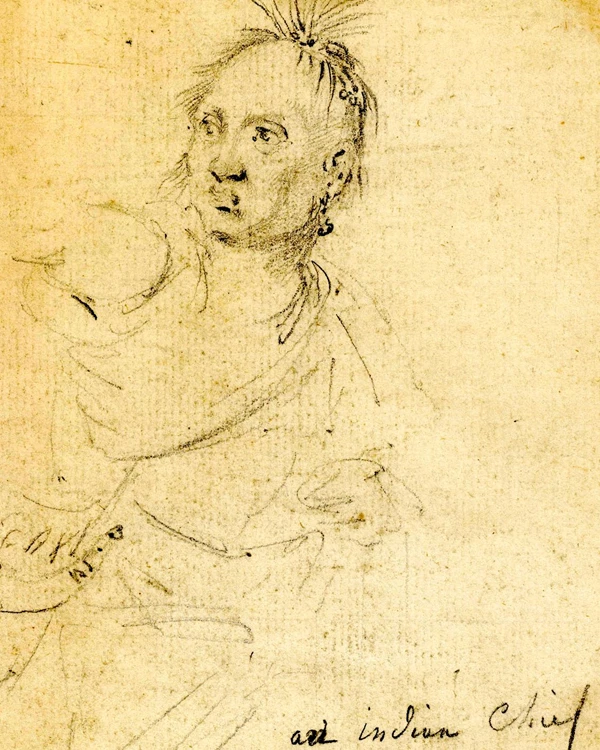Last updated: January 29, 2025
Person
Atayataghlonghta – Colonel Louis Joseph Cook

Yale University Art Gallery
Colonel Louis (also known as Colonel Joseph Louis Cook, Akiatonharónkwen, and Nia-man-rigounant, c. 1740-October 1814) – The highest-ranking officer of both Black and American Indian descent commissioned in the Continental Army. Born in Saratoga, New York, Louis had an African father and a Saint-François Abenaki mother.1 His parents probably named him Nia-man-rigounant, which means “variegated bird.”2 In 1745, a joint French-Kahnawà:ke raid took the family captive. The Mohawks of Kahnawà:ke formally adopted the child, and renamed him Akiatonharónkwen, which translates to “he unhangs himself from the group.”3 He grew up near a Jesuit mission, where he learned to read and write. The young man converted to the Roman Catholic religion and received the name Colonel Louis at his baptism.4 “Intelligent, ambitious, and fluent in French, English, and Mohawk, Louis became a prominent chief.”5 In the French and Indian War, Louis joined the Mohawks of Kahnawà:ke in their campaigns against the British near Lake George and Lake Champlain. He took up arms again with the revolution, aiding the 1775 Patriot invasion of Quebec, which ultimately failed and forced Louis to retreat with them. He later fought at Oriskany and in the Saratoga Campaign. In May 1778, Louis joined the Oneida delegation to Valley Forge. General Steuben’s military secretary Peter Stephen Du Ponceau described walking in a wood near his quarters one morning, only to stumble upon a tall Indian figure in American regimentals singing a fashionable French opera. A surprised Du Ponceau stated, “He would have been a valuable acquisition to the French Opera, where I have never heard a voice of such extraordinary power, and at the same time susceptible of modulation.”6 Instead of pursuing a career in opera, Louis continued in his wartime leadership role, where his powerful voice likely aided his oratorial skills. On June 15, 1779, he received a commission of Lieutenant Colonel from the Continental Congress. It remains “the only known commission given to a man of African descent.”7 After the American Revolution, Louis convinced the Oneida to lease approximately 5 million acres. He cited the prosperity derived from leases by the Mohawks of Kahnawà:ke. Subsequently, the Oneida leased their land to Colonel John Livingston for 999 years, thinking that they could maintain territorial control as landlords.8 Yet, the New York government declared the leases invalid, took the land by military force, and then resold it. Despite these losses, Louis continued to represent the Oneida in negotiations between 1792 and 1796.9 By then, he had settled in Akwesasne, a Mohawk community in the St. Lawrence valley.10 Despite his advanced age, Louis fought at the 1814 Battle of Lundy’s Lane, where American forces were defeated when they invaded Canada. He fell from his horse, and later died of his injuries at the approximate age of seventy-four. Louis was buried near Buffalo, New York—with military honors given at his funeral.11 1. Barbara Graymont, “ATIATOHARONGWEN,” in Dictionary of Canadian Biography, vol. 5, University of Toronto/Université Laval, 2003–, accessed September 23, 2020, http://www.biographi.ca/en/bio/atiatoharongwen_5E.html. 2. Darren Bonaparte, “Colonel Louis at Oriskany and Valley Forge,” Wampum Chronicles, accessed September 2, 2020, https://www.wampumchronicles.com/oriskanyandvalleyforge.html. 3. Darren Bonaparte, “Colonel Louis Cook,” Wampum Chronicles, accessed September 2, 2020, https://www.wampumchronicles.com/toomanychiefs6.html. 4. Darren Bonaparte, “Louis Cook: A “Colonel” of Truth?,” Wampum Chronicles, accessed September 2, 2020, https://www.wampumchronicles.com/coloneloftruth.html.; and Darren Bonaparte, “Colonel Louis at Oriskany and Valley Forge,” Wampum Chronicles, accessed September 2, 2020, https://www.wampumchronicles.com/oriskanyandvalleyforge.html. 5. Alan Taylor, The Divided Ground (New York: Alfred A. Knopf, 2006), 172. 6. Darren Bonaparte, “Colonel Louis at Oriskany and Valley Forge,” Wampum Chronicles, accessed September 2, 2020, https://www.wampumchronicles.com/oriskanyandvalleyforge.html. 7. Euell A. Nielsen, “Colonel Joseph Louis Cook (ca. 1737-1814),” BlackPast, August 3, 2020, https://www.blackpast.org/african-american-history/colonel-joseph-louis-cook-ca-1737-1814/. 8. Alan Taylor, The Divided Ground, 173. 9. Barbara Graymont, “ATIATOHARONGWEN.” 10. Alan Taylor, The Divided Ground, 225. 11. Euell A. Nielsen, “Colonel Joseph Louis Cook (ca. 1737-1814).”Endnotes
- Duration:
- 1 minute, 13 seconds
Did you know that a man of African and Mohawk descent fought at the Battle of Oriskany?
